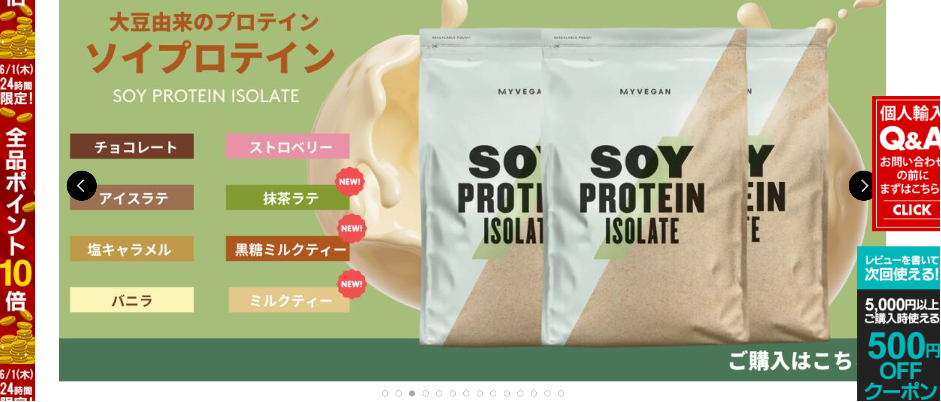
2023 Food and Beverage Trends in France
Share This Post France’s culinary world is distinguished by its ongoing engagement with specific trends and commitment to culinary innovation. The French food and beverage

Discover the incredible potential of Japan’s e-commerce landscape, ranked third-largest worldwide. With a remarkable internet penetration rate of 91%, this market is ripe with opportunities for those seeking lucrative ventures. By 2030, the sector is projected to reach an astounding value of £262.6 billion GBP / €304 billion EUR, with a remarkable CAGR of 10.6%.
This article provides an essential overview of Japan’s e-commerce ecosystem, empowering you to navigate the intricacies of selling through two of the country’s most popular marketplaces: Rakuten Ichiba and Amazon Japan. Unleash the power of these platforms to propel your business to new heights and tap into the vast potential of Japan’s e-commerce landscape.
Overview of Japan’s E-commerce Ecosystem
Japan’s e-commerce market is dominated by three major players: Rakuten Ichiba, Amazon Japan, and Yahoo! Shopping. Both local and international companies widely utilise these market leaders to sell products directly and efficiently. On the other hand, other platforms like brand-owned sites and apps, C2C platforms, shopping apps, and social commerce channels have a smaller user base and market share. These platforms primarily cater to smaller-scale businesses and individuals looking to sell used goods.
While Rakuten Ichiba and Amazon Japan will be the main focus of this article, it’s important to note that access to Yahoo! Shopping is currently restricted for users in the UK and European Economic Area (EEA) and won’t be covered in detail here.
Advantages of using E-commerce platforms
There are many advantages to considering e-commerce marketplaces in Japan as an initial way to gain a foothold. Firstly, mobile usage in Japan has far overtaken desktop devices, especially for online shopping, so having a strong ‘m-commerce’ strategy will be a crucial step in connecting with your Japanese customers.
Secondly, selling via a Japan-owned marketplace that is visibly trusted by others is highly recommended since the Japanese rarely purchase items directly from foreign websites.
There are three critical reasons for this:
In addition to the above considerations, Japan’s tax, safety and compliance system is another major hurdle that can trip up even the most experienced businesses. Although the payoff can be lucrative, navigating the necessary regulations can be challenging. Therefore, working alongside local experts with strong knowledge and experience in running all aspects of e-commerce is extremely important.
Finally, Japan has a strong reputation for e-commerce Logistics. Due to a strong culture that prioritises convenience and sets high expectations for customer service, arranging redeliveries is considered undesirable in Japan. Therefore, companies have adopted several ways for customers to receive packages, such as; contact-free methods such as oki-hai, a delivery drop-off concept that enables customers to receive their items at a time and place to suit them.
Delivery lockers are becoming an increasingly common option for collecting packages, with commuters often preferring to collect on their way to or from work. There are more than 6,000 lockers at train stations across Japan, largely thanks to a partnership between French company Quadient and Japanese logistics giant Yamato Transport Co. This has helped address the rising demand for flexible package collection in Japan.
Japanese customers want to receive items they’ve ordered online in an efficient, respectfully packaged, and timely manner. As a result, ensuring you have a smooth logistics plan in place is vital when fulfilling orders from your e-commerce store.
Japan’s Top E-commerce Marketplaces for Overseas Sellers
Rakuten Ichiba
Overview
Rakuten Ichiba is one of Japan’s leading full-service e-commerce marketplaces. It has been active for more than 26 years. As a result, it has developed a solid reputation among Japanese consumers, to the extent that more than a quarter of all online sales in Japan can be attributed to Rakuten Ichiba alone.
In 2022, more than 135 million Rakuten user IDs were registered, and as an overall entity, Rakuten Group boasts more than 39 million monthly active users (up 11.2% from FY2021), with 76% of those using at least two of Rakuten’s numerous offerings each month, including Rakuten Ichiba. This figure continues to grow year on year, and sales from businesses based in the US and Europe have doubled since 2019.
As of Q4 of 2022, more than 57,000 merchants were operating on the marketplace. The company’s strong user base makes it one of the most accessible ways to reach Japanese consumers, particularly those looking for fashion, gourmet, and household products.
Last year, Rakuten Ichiba announced a strategic partnership with Mamenta, a US-based company providing a Global Trade Platform. This service was integrated into the Rakuten Merchant Server, which facilitates smoother management of data, product inventory, and customer communications, among other aspects. This is welcome news if you’re looking to enter the Japanese market, as it feeds into Rakuten’s overall strategy to attract more overseas sellers.
The Rakuten Ichiba Direct Shop Plan
All overseas sellers who wish to sell via Rakuten Ichiba must first apply for the Direct Shop Plan, requiring a commitment to a minimum 1-year contract at an initial upfront cost of ¥60,000 JPY (£347 GBP/€401 EUR), followed by a further ¥50,000 JPY (£289 GBP/€334 EUR) monthly service fee.
There are several benefits for overseas businesses setting up a shop on Rakuten Ichiba:
Rakuten Ichiba consultants are available at each stage to provide specialist support, specifically; an ‘Onboarding Consultant’ to get you set up, a ‘Shop Open Advisor’ to assist with creating the storefront, and an ‘E-commerce Consultant’ (ECC) to help maximise your sales potential. This support is included in the cost of the Direct Shop Plan.
The Direct Shop Plan is only for companies that can operate and communicate in Japanese. This is because the Rakuten Merchant Server (RMS) store interface requires fully proficient use of Japanese across all set-up and management touchpoints. Therefore, we recommend partnering with a reputable company that deeply understands your business needs as well as navigating the intricacies of the Japanese market.
Within Europe, the Direct Shop Plan is currently only available for entities based in the UK, France, and Germany. European entities outside these countries must sign a contract with Rakuten’s approved third-party partners to sell via the marketplace.
Fulfilment solutions are not provided, but Rakuten Ichiba recommends using a Japanese logistics company for fulfilment to build customer trust and meet expected delivery standards. This does, however, mean additional costs on top of the Direct Shop Plan subscription and associated selling fees.
Customer support is available in Japanese via the following channels; chatbot (5-10 minutes), phone (30 minutes), and email (reply within 3 days).
Selling on Rakuten Ichiba
Although most categories are suitable for selling via Rakuten Ichiba, the sale of specific products is prohibited, including; raw produce, pet food, liquid chemicals, cleaning products, seeds for farming, and weapons. In addition, overseas vendors should also not sell items containing CBD (cannabidiol) or any used products.
Selling fees are charged as follows:
For more information, free resources are available, including an e-book and a webinar.
Examples of European companies that have successfully opened their e-commerce stores via Rakuten Ichiba include; protein supplement store MYPROTEIN and watchmaker Daniel Wellington.

Example of a localised storefront on Rakuten Ichiba, including customer Q&A and special discount coupon tabs. Source: MYPROTEIN Store on Rakuten
Amazon Japan
Overview
Many businesses already use Amazon as their primary e-commerce marketplace outside of Japan, so this might also be your most natural choice for the Japanese market. Amazon Japan has at least 52.5 million monthly active users. Once live on the platform. However, the level of competition may be higher in comparison since Amazon Japan also sells white-label offerings alongside branded products.
On the flip side, note that while there are many positives to selling on Amazon Japan, competition can be intense. The reach is vast, but the choice can become overwhelming for customers, and it can take a significant amount of effort to make your offering stand out in a crowded marketplace.
Japanese customers also expect to pay less for items they buy online and, as a result, are searching for special deals. Therefore, the level of business you’re generating must be high enough to account for this expectation and cover all associated fees.
Setting up an Amazon Japan Account
The first step to selling via Amazon Japan is to know precisely what types of products you will list and familiarise yourself with the relevant tax laws and regulations. Once this is in place, you can then go ahead and register for a Japan account. If you are already active on Amazon in Europe or North America, that account can be linked to Amazon Japan. An overview of all global listings is readily available on one dashboard.
Companies selling via Amazon Japan should choose the Professional Plan, which enables unlimited listings for a fixed monthly fee. Another option is the Individual Plan, but this is aimed at those wishing to sell at least 50 products per month. Some product categories are only available to Professional Selling partners.
Amazon Japan also provides guidance around planning to run special promotional campaigns in the lead-up to peak holiday periods, such as Golden Week and Valentine’s Day. This can be helpful to take advantage of seasonal trends and attract customers at popular times.
Selling on Amazon Japan
Below is an indication of the fees payable under the Professional Plan on Amazon Japan:
See a full, current breakdown of Amazon Japan’s selling fees here.
Amazon Japan offers a handy reference guide in English for companies looking to sell via the marketplace. This can be downloaded here. The guide covers everything you need to know from; preparing to sell, registering and listing items, shipping and fulfilment options, and managing your Amazon Japan store.
Some European brands that have experienced success on Amazon Japan include British elegant jewellery storage solutions and bag company Stackers London, and camping equipment manufacturer Coleman.

Example of a localised Amazon Japan store. Source: Coleman store
Launch your Business on E-commerce Marketplaces in Japan
E-commerce is an effective entry route into Japan, particularly if you’ve already built up a strong reputation across other markets. Despite this, we know it can seem daunting to navigate the wide range of options available to you as an overseas seller.
The team at operviser can connect you with knowledgeable experts who can guide you through the process, launch your business in the Japanese market, and ultimately set you on the path to long-term success.
Get in touch to discuss your e-commerce strategy for the Japanese market.

Share This Post France’s culinary world is distinguished by its ongoing engagement with specific trends and commitment to culinary innovation. The French food and beverage

Share This Post Before choosing to sell your product or service in the Japanese market, it’s essential to understand the nuances behind Japanese consumer psychology.
